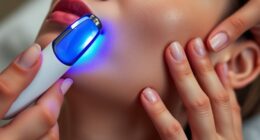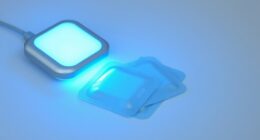Hyaluronic acid’s molecular structure plays a key role in how your skin absorbs hydration, especially when combined with light therapy. Smaller molecules penetrate deeper, boosting moisture inside your skin and supporting collagen production, while larger ones stay on the surface to lock in moisture. Light therapy increases blood flow and cellular activity, helping hyaluronic acid work more effectively. To discover how these interactions can enhance your skincare routine, keep exploring the science behind this powerful combo.
Key Takeaways
- Hyaluronic acid’s molecular size determines its ability to hydrate surface skin versus penetrating deeper layers.
- Light therapy enhances blood flow and cellular activity, improving hyaluronic acid absorption into skin tissues.
- Smaller hyaluronic acid molecules penetrate deeper, boosting collagen production and overall skin hydration.
- Larger molecules form a barrier on the skin surface, locking in moisture and preventing dehydration.
- Combining hyaluronic acid with light therapy optimizes hydration, skin repair, and youthful appearance.

Have you ever wondered how hyaluronic acid works to keep your skin youthful and hydrated? The secret lies in its ability to penetrate the skin effectively, which depends heavily on skin absorption and its molecular structure. Hyaluronic acid is a naturally occurring substance in your body, mainly found in connective tissues, eyes, and skin. When applied topically or through treatments, its primary function is to attract and retain moisture, keeping your skin plump and smooth. However, for it to work efficiently, understanding how its molecular structure influences skin absorption is essential.
Hyaluronic acid’s molecular structure is composed of long chains of sugar molecules called polysaccharides. These chains can vary in size, creating different forms such as high molecular weight and low molecular weight hyaluronic acid. High molecular weight variants are larger, forming a protective barrier on the skin’s surface that helps lock in moisture. Conversely, low molecular weight hyaluronic acid has smaller molecules that can penetrate deeper into the skin layers. This ability to penetrate is fundamental because it allows the acid to deliver hydration not just on the surface but within the deeper layers of your skin, where collagen and elastin production occurs. This deeper skin absorption is what makes hyaluronic acid so effective in reducing the appearance of fine lines and wrinkles.
The molecular structure also influences how well hyaluronic acid can be absorbed during skincare routines or treatments like light therapy. Light therapy, especially when combined with hyaluronic acid, enhances skin absorption by increasing blood flow and stimulating cellular activity. This makes it easier for hyaluronic acid molecules to penetrate deeper and work more efficiently. When your skin absorbs hyaluronic acid effectively, it promotes a more profound hydration process, leading to a bouncy, youthful appearance.
Moreover, the size of hyaluronic acid molecules determines how they interact with skin cells. Smaller molecules can slip through the skin’s barriers more easily, reaching the dermis, where they can boost moisture levels and support tissue repair. Larger molecules tend to stay on the surface, forming a barrier that prevents moisture loss. This combination of molecular sizes allows skincare formulations to provide both immediate surface hydration and long-term, deeper moisture retention.
In essence, understanding the skin absorption capabilities of hyaluronic acid, driven by its molecular structure, explains why it’s so effective in skincare. Its ability to penetrate deeply, combined with the benefits of light therapy that enhances cellular activity, makes hyaluronic acid a powerful ally in your quest for youthful, well-hydrated skin. Properly formulated products that consider molecular size and skin absorption will give you the best results, helping you achieve a radiant, hydrated complexion.
Frequently Asked Questions
How Does Light Therapy Enhance Hyaluronic Acid Absorption?
Light therapy enhances hyaluronic acid absorption through deep light penetration that reaches your skin’s layers. This process stimulates cellular activity, encouraging your cells to produce more hyaluronic acid naturally. As your cells get activated, they become more receptive to topical hyaluronic acid, improving hydration and plumping your skin. So, by boosting cellular stimulation, light therapy helps your skin better absorb and retain hyaluronic acid, ultimately making your skin look more radiant and youthful.
Can Hyaluronic Acid Improve Skin Elasticity Over Time?
You bet hyaluronic acid can improve your skin’s elasticity over time. It helps combat aging effects by boosting collagen production and keeping your skin deeply hydrated. Think of it as hitting two birds with one stone—hydration and collagen support work together to tighten and firm your skin. Consistent use enhances elasticity gradually, helping your skin look plumper and more youthful as the years go by.
Are There Risks Associated With Combining Hyaluronic Acid and Light Therapy?
You might wonder if combining hyaluronic acid and light therapy poses risks. Generally, there are minimal product interactions, but you should watch for allergy concerns, especially if you have sensitive skin. Always patch-test new products and consult a dermatologist before combining treatments. While hyaluronic acid is safe and hydrating, light therapy could cause irritation if misused, so follow instructions carefully to avoid adverse reactions.
How Long Does It Take to See Results From Hyaluronic Acid Treatments?
You’ll notice skin plumping and improved moisture retention within a few days to a week after hyaluronic acid treatments. Consistent use enhances hydration, making your skin look fuller and more radiant. Results can vary based on individual skin type and product strength, but most people see visible improvements in skin texture and elasticity within this timeframe. Keep up with treatments to maintain ideal hydration and long-term skin health.
Does Hydration Influence the Effectiveness of Light Therapy Sessions?
Think of your skin as a sponge—if it’s dry, it can’t absorb the benefits fully. Hydration levels directly influence the effectiveness of light therapy sessions, as well-moisturized skin enhances light penetration and stimulates better results. When your skin maintains ideal moisture, it’s more receptive to treatment, allowing light therapy to work more efficiently and improve overall skin health. So, stay hydrated for the best glow!
Conclusion
So, next time you splash on that fancy moisturizer, remember: hyaluronic acid isn’t just a pretty ingredient—it’s your skin’s best friend in the hydration game. Combine it with light therapy, and you’re basically giving your face a VIP spa day without the hefty price tag. Who knew that a tiny molecule could be such a superhero? Now go ahead, hydrate like you mean it—your skin’s future self will thank you (probably with a glow).







